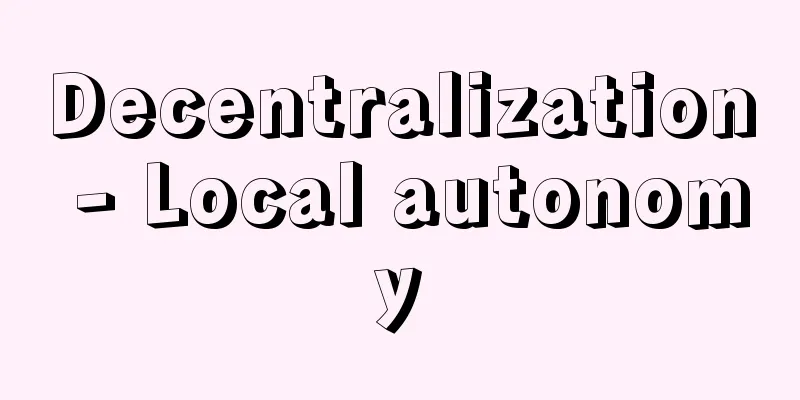Decentralization - Local autonomy

|
The idea that local politics should be conducted through representatives (such as local assembly members or mayors) or local political institutions chosen by local residents, or such political institutions. As Bryce says, "local autonomy is the school of democracy," after the establishment of modern nations, democracies such as the United Kingdom and the United States established the political principle of respecting local autonomy. In modern nations, politics are conducted based on one authority, one government, and one law, and in that sense, while it is premised that the supreme will of the state should always be centralized, the idea of decentralization is that such supreme will should be formed based on the interests of the local areas. In Japan before the Second World War, there was no explicit provision on local autonomy in the Constitution, and local politics were led by governors appointed by the central government under the supervision and instructions of the central government, which was called centralized politics. After the war, a chapter on "local autonomy" was created in the Constitution of Japan, which stipulates that "matters relating to the organization and administration of local public entities shall be determined by law in accordance with the principles of local autonomy" (Article 92) and "(1) Local public entities shall establish assemblies as their deliberative organs, as provided for by law. (2) The chief executive officer, members of their assemblies, and other local officials as provided for by law shall be elected directly by the residents of the local public entity" (Article 93). This systemically guaranteed decentralization, and residents' movements calling for democratic politics, such as the opposition to the construction of nuclear power plants through referendums and the opposition to the construction of military bases in Okinawa, became more active. However, as the term "30% autonomy" suggests, local governments can only collect 30 to 40% of their revenues, and are forced to rely on the national government for the rest of their revenues. In addition, nearly 70% of local government administration is delegated by the national government, which is a far cry from the realization of healthy local politics through decentralization. Calls for "local autonomy reform" began to be heard from around the end of the 1990s. In 1999, the Local Autonomy Comprehensive Law was enacted, and during the Koizumi administration in particular, the direction of "realizing an autonomous society" by transferring authority and revenues to local governments in the form of the "trinity policy" was promoted. In 2006, the Local Autonomy Reform Promotion Law was enacted, and in 2007, the Local Autonomy Reform Promotion Committee was established, which submitted four recommendations to the Prime Minister by November 2009. The Democratic Party of Japan cabinet of Yukio Hatoyama, which came into power in September 2009, set out a "regional autonomy reform" initiative that aimed to put local governments and local residents in charge of "town development," and promoted the enactment of a comprehensive bill to promote regional autonomy. Behind this shift from "decentralization" to "regional autonomy" is thought to be the influence of the National Association of Governors and other organizations. [Hiroshi Tanaka] [References] | | | |Source: Shogakukan Encyclopedia Nipponica About Encyclopedia Nipponica Information | Legend |
|
地方の政治は地方住民が選んだ代表者(議員・長など)や地方政治機関を通じて行うべしとする考え方、あるいはそのような政治機構。「地方自治は民主主義の学校である」(ブライス)といわれるように、近代国家成立後、イギリス、アメリカのような民主主義国家では、地方自治尊重の政治原理を確立した。近代国家では、一つの権力、一つの政府、一つの法律に基づいて政治が行われ、その意味で国家の最高意志はあくまで中央に集権されるべきであるという前提にたちつつも、そのような最高意志は地方の利益を基礎に形成されるべきであるという考えが地方分権の思想である。 第二次世界大戦前の日本では、憲法上、地方自治に関する明文の規定はなく、中央政府の任命する知事が中央の監督・指示に従って地方政治を指導したので、中央集権的政治とよばれた。戦後は、日本国憲法において「地方自治」という1章をとくに設け、「地方公共団体の組織及び運営に関する事項は、地方自治の本旨に基いて、法律でこれを定める」(92条)、「(1)地方公共団体には、法律の定めるところにより、その議事機関として議会を設置する。(2)地方公共団体の長、その議会の議員及び法律の定めるその他の吏員は、その地方公共団体の住民が、直接これを選挙する」(93条)と規定している。これにより、地方分権が制度的に保障され、住民投票などを通じての原子力発電所設置反対、沖縄基地反対運動にみられるような民主政治を求める住民運動も活発化した。 しかし、「3割自治」といわれるように、地方公共団体が徴収できる財源は3、4割にすぎず、その他の財源は国に依存せざるをえない。また地方公共団体の行政の7割近くが国からの委任事務であるという地方自治の現状では、地方分権による健全な地方政治の実現というにはほど遠く、1990年代末ごろから「地方分権改革」が叫ばれるようになった。すなわち1999年(平成11)に地方分権一括法が制定され、とくに小泉政権時代に「三位一体(さんみいったい)政策」という形での地方への権限と財源の移譲による「自治型社会の実現」を目ざす方向が進められた。そして2006年には地方分権改革推進法が成立し、2007年には地方分権改革推進委員会が設けられ、2009年11月までに4回の勧告が内閣総理大臣に提出された。2009年9月に成立した鳩山由紀夫(はとやまゆきお)民主党内閣は、自治体と地域住民が「まちづくり」の主体になることを目ざす「地域主権改革」を掲げ、地域主権推進一括法案の制定を進めた。こうした「地方分権」から「地方主権」への転換という背景には、全国知事会などの影響力も考えられる。 [田中 浩] [参照項目] | | | |出典 小学館 日本大百科全書(ニッポニカ)日本大百科全書(ニッポニカ)について 情報 | 凡例 |
Recommend
Oronuku
…Originally, the act of pulling out seedlings of ...
Descriptive Geometry - Gahouki Kagaku
It is a branch of geometry that studies the shape...
Ideological School - Kannengaku is (English spelling) ideologues
In 1796, Destutt de Tracy first proposed the idea ...
Urashima Azalea - Urashima Azalea
A deciduous small shrub of the Ericaceae family th...
Cutting edge
〘Noun〙① = kiriha (cutting edge)② A cut in a Joruri...
Thyseen AG
A German steel company. Founded in 1871 by August ...
Billroth - Christian Albert Theodor Billroth
Austrian surgeon. He established the foundations ...
Kanrantei
(Matsushima Town, Miyagi County, Miyagi Prefecture...
Ground beetle - Garbage beetle
This insect belongs to the family Carabidae of th...
Castro, E.de - Castro
…The most representative poets of the fin de sièc...
Abu Simbel
Two rock-cut temple ruins on the west bank of the ...
Red starfish - Red starfish
A marine animal belonging to the phylum Echinoder...
Medicine ball - Kusudama
It is made by cutting perfumes such as musk, aloe...
Zoroaster
…A religion founded by Zoroaster in northeastern ...
Tights (English spelling)
A stretchy leg garment that tightly envelops the s...









